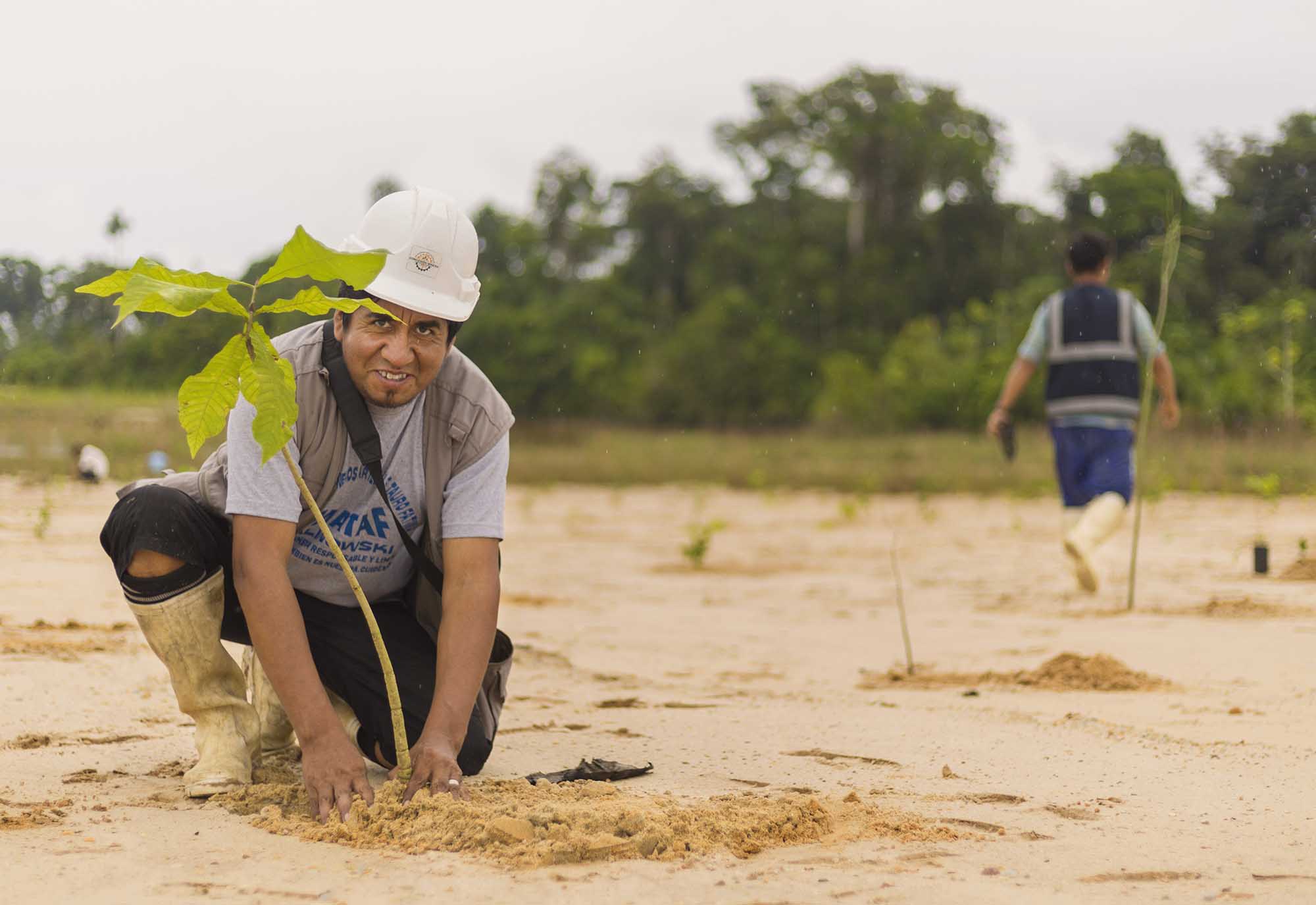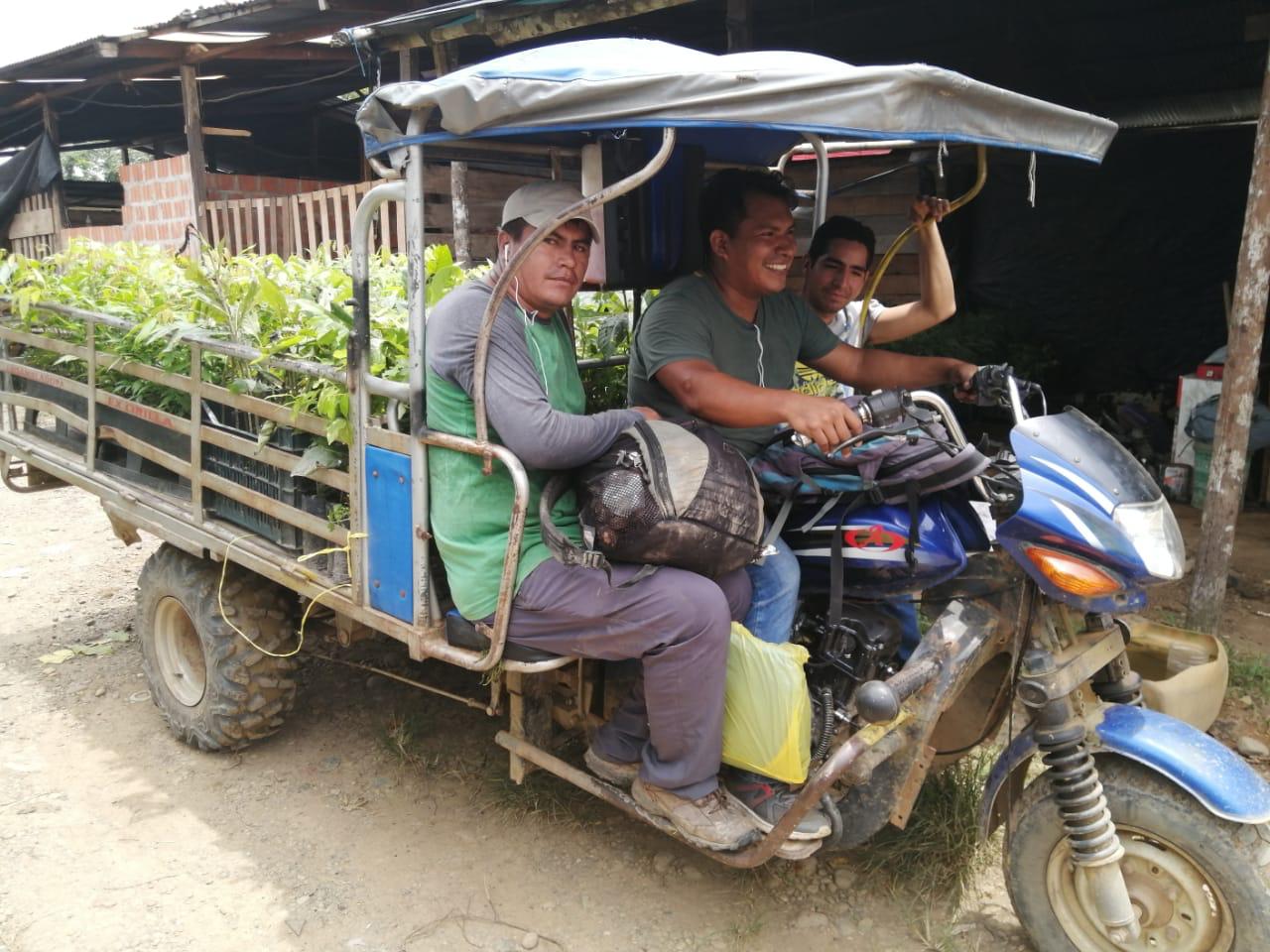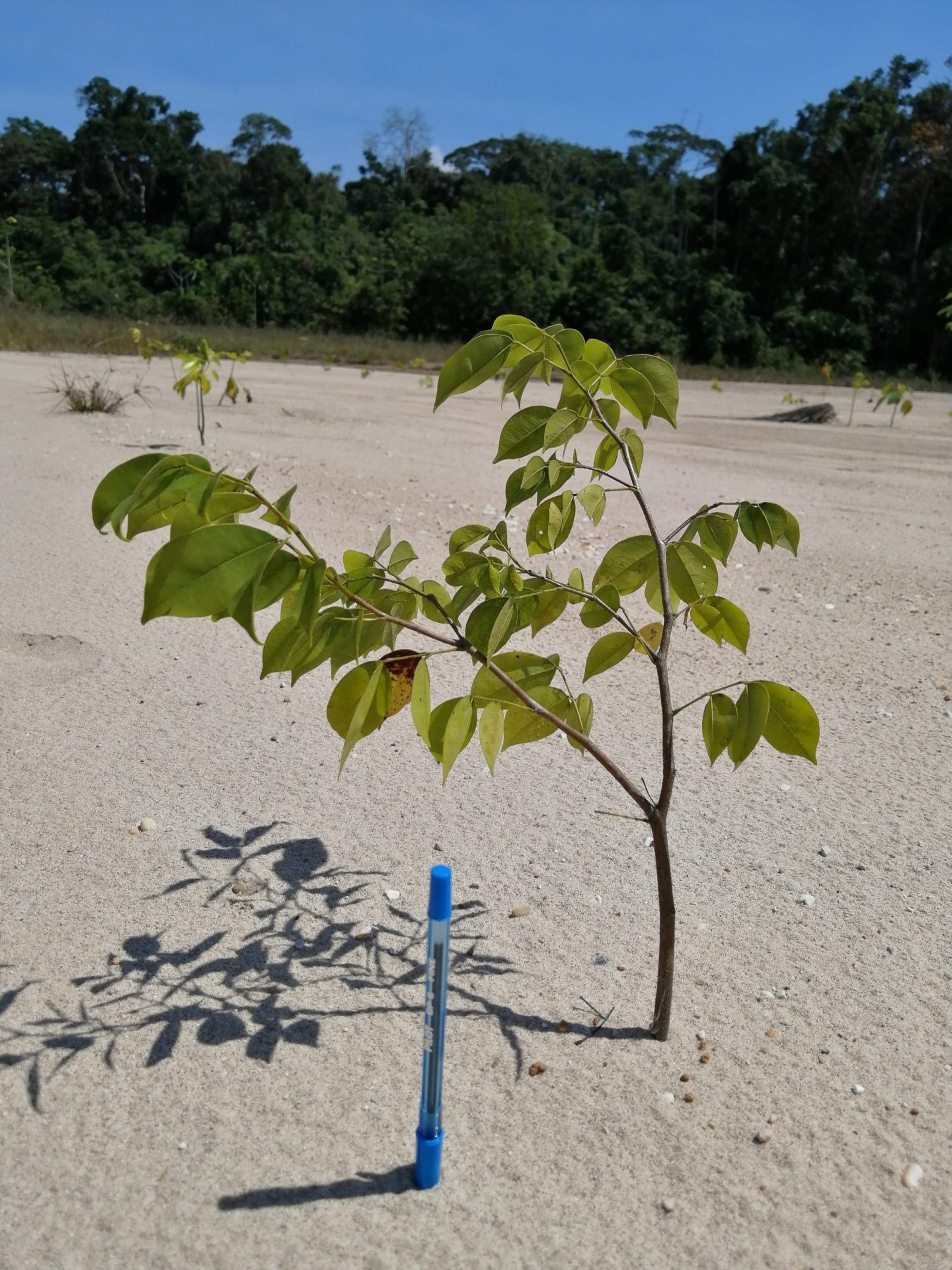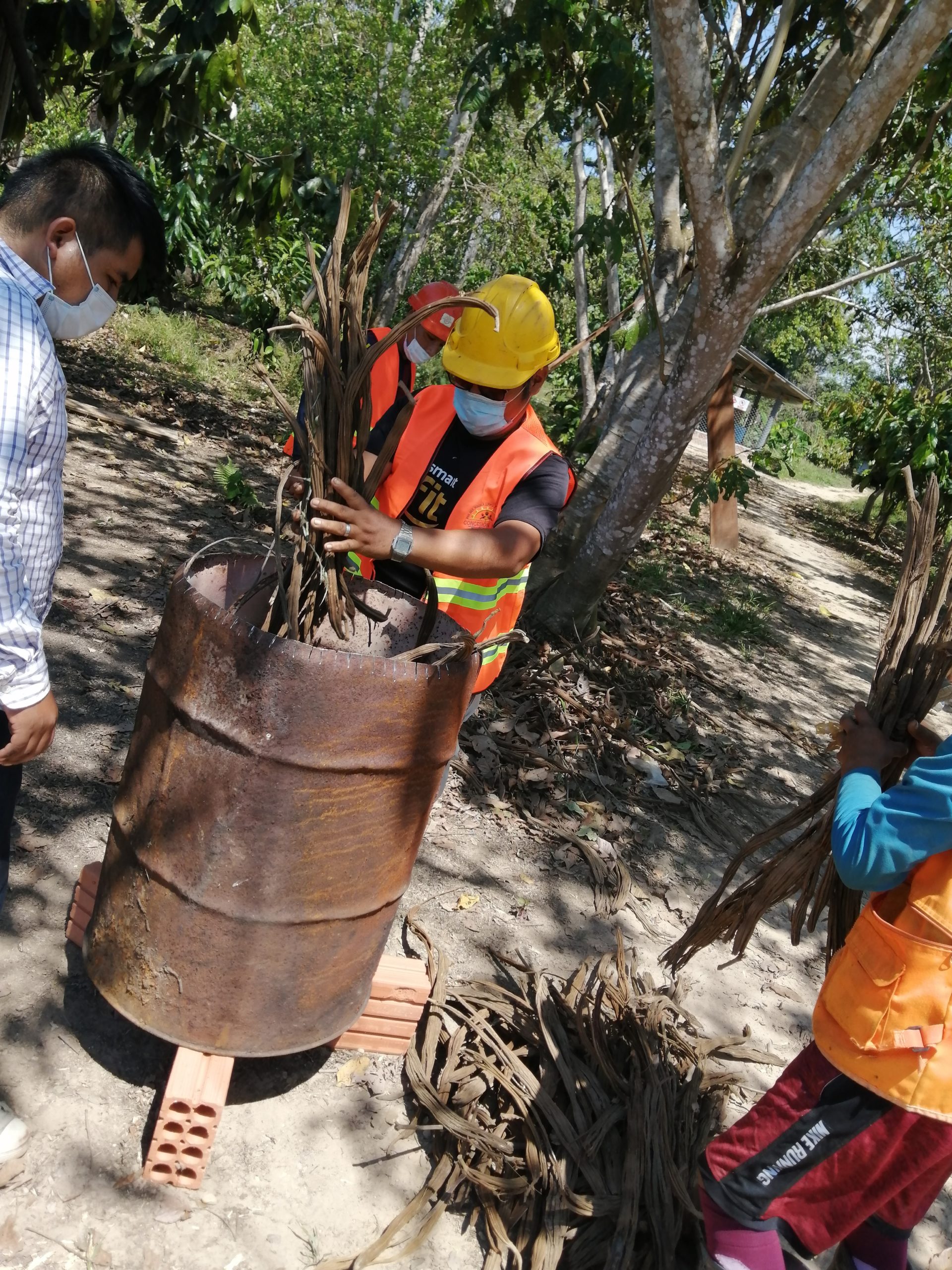Along with local partners, Pure Earth started the reforestation of more than 3.5 hectares of rainforest in the Peruvian Amazon in 2017 and 2018. Another 2.5 hectares was restored in 2020. This report is from Pure Earth’s Charles Espinosa.

Miners and Pure Earth team members standing beneath the Linda II Mining Concession entrance.
Located in the Peruvian Amazon, the Tambopata National Reserve is home to 1,200 species of butterflies and iconic mammals like the jaguar.
Despite strict laws protecting the area around the reserve, known as the “buffer zone,” illegal miners have cut down over 37,000 football fields of forest since 2016, and converted an area roughly the size of Manhattan into pools contaminated with mercury.
With Pure Earth’s support and a grant from The Tiffany & Co. Foundation, the AMATAF Mining Association is reversing this toxic legacy. Founded in 1987 by a coalition of low-income farmers, AMATAF is one of the few artisanal mining associations working legally in the buffer zone.
“AMATAF has always sought a clean and responsible form of mining. That’s the miner’s obligation,” says Hugo Quispe, owner of the Linda II Mining Concession and member of AMATAF.

Hugo Quispe, owner of the Linda II Mining Concession and member of AMATAF, fulfilling his obligation to the rainforest.
True to his word, Hugo asked Pure Earth for help on how to ecologically restore degraded land in his concession.
This isn’t new for Pure Earth. Pure Earth reforested 2.5 hectares in the Paolita II Mining Concession in 2017 and one hectare in the FORTUMIL Mining Concession in 2018.
What makes Pure Earth’s work with AMATAF novel is the miners’ unprecedented commitment to the rainforest and responsible mining. Here’s what we’ve accomplished together this year:
These two local ecology students were part of our team working to plant the seedlings.
Step 1: Pilot Mine Closure
In February 2020, a team of 12 miners and 16 field experts, including local ecology students, restored 2.5 hectares in Hugo’s concession. This pilot mine closure will serve as a model for Hugo on how to ecologically restore land that he has already mined for gold.
After creating a geospatial map of the plantation area, the work team ferried 2,778 seedlings from the capital city of Puerto Maldonado. Among the ten different species was the legendary Shihuahuaco tree, which can live for up to 1,000 years, reach 40 m in height, and sequester about as much carbon as one third of an average hectare of rainforest.

Next, miners and field experts applied a set of carefully researched fertilizers to the soil and leaves. Before leaving, the team measured and catalogued the dimensions of all planted seedlings to monitor future progress.
Throughout the process, Pure Earth Project Coordinator France Cabanillas noted that miners expressed more enthusiasm in the restoration than he had previously seen.
Not only did 12 miners participate, miners from other concessions gathered in the area, asking how they can restore their own mining areas.

Seedlings were planted in neat rows.
Step 2: Evaluate and Fertilize
Delayed for months by the COVID lockdown, the work team finally returned to the plot in late August. After masking up and passing a temperature test to enter Hugo’s concession, Pure Earth’s technicians fertilized all surviving seedlings and took soil samples to monitor any changes in mercury levels and other soil properties.
Despite having to wait almost six months, the team was thrilled to discover that 87% seedlings survived, a rate considered in the field as “excellent.”

Two team members taking soil samples to monitor any changes in mercury levels and other soil properties.

A pen inserted into the ground gives team members a reference to gauge approximate seedling height.
Step 3: Reforestation Training and the Magic of Biochar
Restoring 2.5 hectares of degraded land has a big impact.
In fact, a single hectare of Amazon rainforest harbors up to 300 species of trees (there are 81 across all of New England) and stores 120 to 350 tons of carbon.
Even so, giving miners the tools to continue restoring their mines in years to come is even more important. That’s why, at Hugo’s request, Pure Earth held an official training in late August for nine miners in Amazon restoration methodology, developed by our partner CINCIA.

Miners in masks attend a workshop on reforestation.
During the training, experts taught miners how to make biochar, a charcoal soil amendment invented by ancient Amazonian societies.
Biochar was selected as one of the top 100 solutions by Project Drawdown to mitigate climate change and experts like Pure Earth’s Colombia Director Alfonso Rodriguez are researching its potential to absorb contaminants, such as lead and mercury.
Despite the lofty uses of biochar around the world, CINCIA technical expert Larry Huacarpuma showed miners how they can make it in their own backyards by roasting fallen branches and trees in an artisanal furnace.

Demonstrating how to make biochar.
Next Steps: Losing Mercury and Building a Greenhouse
While the pilot restoration and training were huge strides in AMATAF’s commitment to responsible mining, the future may be even brighter.
“One of AMATAF’s goals is to sell mercury-free gold to interested companies and reforest more areas degraded by mining,” says AMATAF President Vilma Contreras Vargas.
Pure Earth plans to help AMATAF make the transition to mercury-free mining and eventually build a greenhouse, where they can grow their own seedlings to restore mines. Hugo and his fellow miners are well on their way to fulfilling the miner’s obligation.
Pure Earth would like to thank The Tiffany & Co. Foundation for its support of community-led reforestation in the Peruvian Amazon and for support to train artisanal gold miners in mercury- free mining methods.
Learn more:
Rainforest Reforestation Brings Degraded Mining Sites Back to Life, Provide Models of Hope





